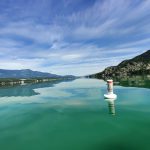Columbia Lake Water Levels 2021
As we head into Fall, the level of our lake is declining and heading to its annual mid-April low. The high water is behind us – the lake crested on June 30th. This year it rose 1.1 metres. That rise was about 20 cm higher than average but 10 cm less than last year.
The annual mid-summer rise is important – it provides the habitat necessary for wildlife to thrive and reproduce. It also drives our local economy. Water from snowmelt is a major contributor to that rise.
The bulk of the meltwater comes from Dutch Creek during the spring when the creek overflows its banks and dumps water into the lake. The rise doesn’t get underway until the average daily temperature reaches and remains above four Deg C. That threshold was reached in late April and is typical of the timing. Once underway, the rise was continuous but interspersed with spurts and falloffs as the weather changed. This year, the first such spurt occurred near mid-May following a rise in temperature but the most significant increase followed the warm weather during the May 31 – June 6 period when the lake rose about 50 cm – nearly half of the annual rise. Following that the level fell off as temperatures cooled but rose again when the abnormally hot weather of late June-early July arrived. A summer maximum temperature of 41.8 Deg C was recorded on June 29 and presumably melted the last remnant of the snowpack (there are no significant glaciers in the Dutch Creek watershed) for the lake level began to fall soon thereafter.
Snow melt is not the only factor affecting lake level though it is certainly the most significant one during spring. Rainfall and groundwater make further contributions. There are also losses. Substantial water is lost through evaporation and consumptive use, especially during July and August.
submitted by William Thompson







